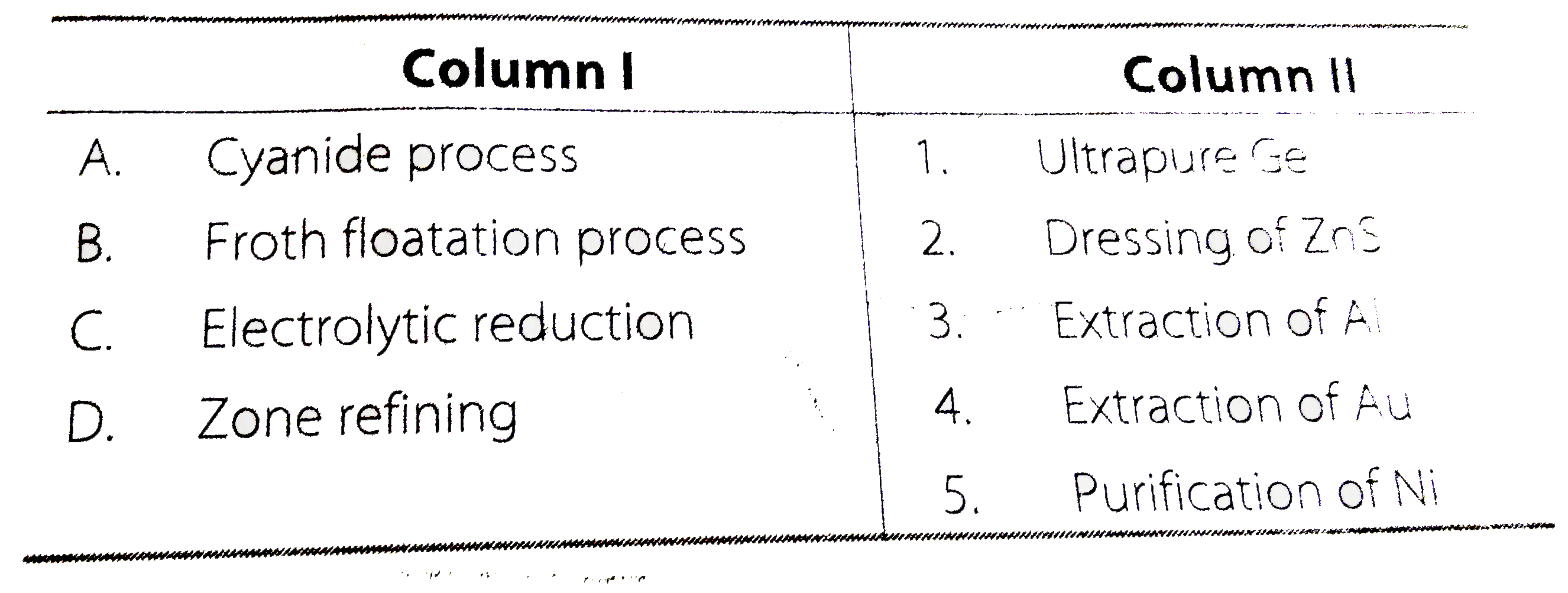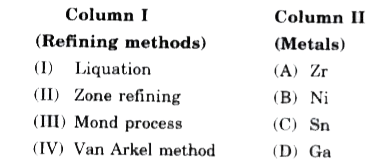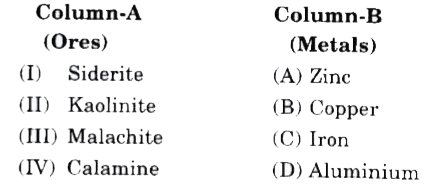Complete Solutions to COMPETION FILE (Objective Questions) (Multiple Choice Question from competitive examinations) of chapter GENERAL PRINCIPLES AND PROCESSES OF ISOLATION OF ELEMENTS of Class 12 book with complete answers and questions
| Class 12 | CHEMISTRY |
| Chapter | GENERAL PRINCIPLES AND PROCESSES OF ISOLATION OF ELEMENTS |
| MODERN PUBLICATION | COMPETION FILE (Objective Questions) (Multiple Choice Question from competitive examinations) |
| Number Of Questions | 49 |
| Academic Year | 2023-24 |
Which of the following srtatement above the advantage of masting of sulphide are before reduction is not true?
02:02View SolutionWhich one of the following ores is treated by chemical leaching
01:34View SolutionWhich of the following pairs of metals uis purified by van arkel method?
01:29View Solutionwhich of the following electronts is present as the impurity to the maximum extent in the pig iron?
02:39View SolutionAluminium is extracted from Alumina (`Al_(2)O_3` ) by electrolysis of a molten mixture of
01:26View SolutionWhich ore of the following is a mineral of iron ?
00:54View SolutionWhich one of the following is not a sulphide ore ?
01:28View SolutionRoasting of sulphides gives the gas X as a by product. This is a colourless gas with choking smell of burnt sulphur and causes great damage to repiratory organs as a result of acid rain. Its aqueous solution is acidic, acts as reducing agent and its acid has never been isolated. The gas X is :-
02:00View SolutionSphalerite is concentrated by
03:15View SolutionIn the extraction of copper from its sulphide ore, the metal finally obtained by the reduction of cuprous oxide with -
01:32View Solution'Metals are usually not found as nitrates in their ores''. Out of the following two (I`andII`) reasons which is//are true for the above obervation?
`I`.Metal nitrates are highly unstable.
`II.` Metal nitrates are highly soluble in water.01:34View SolutionMatch the items of Column I with item of Column II and assign the correct code.
 01:41View Solution
01:41View SolutionExtraction of gold and silver involves leaching with `CN^(-)`ion.silver is later recovered by:
01:31View SolutionConsidering Ellingham diagram, which of the following metals can be used to reduce alumina?
04:42View SolutionWhich one is malachite from the following
01:00View SolutionIdentify the reaction that does not take place in a blast furnace
02:35View SolutionIn the alumino-thermite process, Al acts as :
02:35View SolutionIn view of the signs of `Delta_(r)G^(@)` for the following reactions :
`PbO_(2)+Pbto2PbO,Delta_(r)G^(@)lt0`
`SnO_(2)+Snto2SnO,Delta_(r)G^(@)gt0`,
which oxidation states are more characteristic for lead and tin ?03:15View SolutionWhich method of purification is represented by the following equation?
`Ti(s)+2I_(2)(g)overset(523K)(to) Til_(4)(g)overset(1700K)(to)Ti(s)+2I_(2)(g)`01:50View SolutionThe function of potassium ethyl xanthate in froth floatation process is to make the ore
View SolutionThe first step in the extraction of copper from copper pyrites
View SolutionThe statement that is not correct is
View SolutionRoasted copper pyrite on smelting with sand produces
View SolutionIn the correct of the Hall-Heroult process for the extraction of `Al`, which of the following statements is false ?
03:12View SolutionWhich one of the following ores is the best concentrated by froth floatation method?
03:08View SolutionWhat is the composition of 'Copper matte'?
00:52View SolutionThe complex formed when `Al_(2)O_(3)` is leached from bauxite using concentrated NaOH is :
01:23View SolutionThe metal extracted by leaching with cyanide is
02:18View SolutionPurification of aluminium is called
01:50View SolutionElectrolytic refining's is ued to purify which of the following metals?
02:18View Solutionthe common impurities present in bauxite are
01:38View SolutionCarnallite is an ore of
00:52View SolutionWhich of the following is not a mineral of iron?
01:40View SolutionThe one that is not a carbonate ore is:
01:44View SolutionMatch the refining methods (Column I) with metals (Column II).
 04:49View Solution
04:49View SolutionThe correct statement is :
View SolutionThe pair that does NOT require calcination is :
01:45View SolutionThe reaction that does NOT define calcination is :
01:52View SolutionMatch the ores (Column A) with the metals (Column B) :
 02:10View Solution
02:10View Solutionin the Hall -Heroult process, aluminium is formed at the athode , the cathode is mode out of :
01:06View SolutionThe correct statement is
04:21View SolutionAssertion : For the extraction of iron, haematite are is used.
Reason : Haematite is a carbonate are is used01:21View SolutionThe ore that contains both iron and copper is :
01:32View SolutionHall-Heroult's process is given by :
01:47View SolutionExtraction of zinc from zinc blende is achieved by:
02:52View SolutionOxidation states of the metal in the minerals haematite and magnetite respectively are
01:26View SolutionIn the cyanide extraction process of silver from argentite ore, the oxidising and reducing agents are
01:12View SolutionSulphide ores are common for the metals
01:00View SolutionCalamine, malachite, magnetite and cryolite, respectively, are
01:24View Solution
COMPETION FILE (Objective Questions) (Multiple Choice Question from competitive examinations) questions and complete solutions for chapter GENERAL PRINCIPLES AND PROCESSES OF ISOLATION OF ELEMENTS of MODERN PUBLISHERS CHEMISTRY (HINGLISH) of Class 12
All Exercises from MODERN PUBLICATION Class 12 CHEMISTRY GENERAL PRINCIPLES AND PROCESSES OF ISOLATION OF ELEMENTS
- COMPETION FILE (Integer Type Numerical Value Type Questions)
- COMPETION FILE (Matrix Match Type Questions)
- COMPETION FILE (Objective Questions) (Multiple Choice Question from competitive examinations)
- COMPETION FILE (Objective Questions) (Multiple Choice Question with more than one correct answers)
- COMPETION FILE (Objective Questions) (Multiple Choice Question with only one correct answer)
- Conceptual Questions
- Example
- HOTS (Higher Order Thinking skills) (Advanced Level)
- Memory Test (Choose the correct alternative)
- Memory Test (Complete the missing links)
- Memory Test (Say true or false)
- NCERT FILE (Ncert Exemplar Problems) (Assertion and Reason Type Questions)
- NCERT FILE (Ncert Exemplar Problems) (Matching Type Questions)
- NCERT FILE (Ncert Exemplar Problems) (Multiple Choice Questions (Type-I))
- NCERT FILE (Ncert Exemplar Problems) (Multiple Choice Questions (Type-II))
- NCERT FILE (Ncert Exemplar Problems) (Short Answer Type Questions)
- NCERT FILE (Ncert In-text Questions)
- NCERT FILE (Ncert Textbook Exercises)
- Revision Exercises(Assertion Reason Questions)
- Revision Exercises(CBSE Qs.)
- Revision Exercises(Multiple choice questions
- Revision Exercises(Multiple choice questions)
- Revision Exercises(One word/Short sentence Answer)
- Revision Exercises(Passage Based Questions)
- Revision Exercises(Short answer questions)
